AI Voice Generation Guide to Realistic Audio
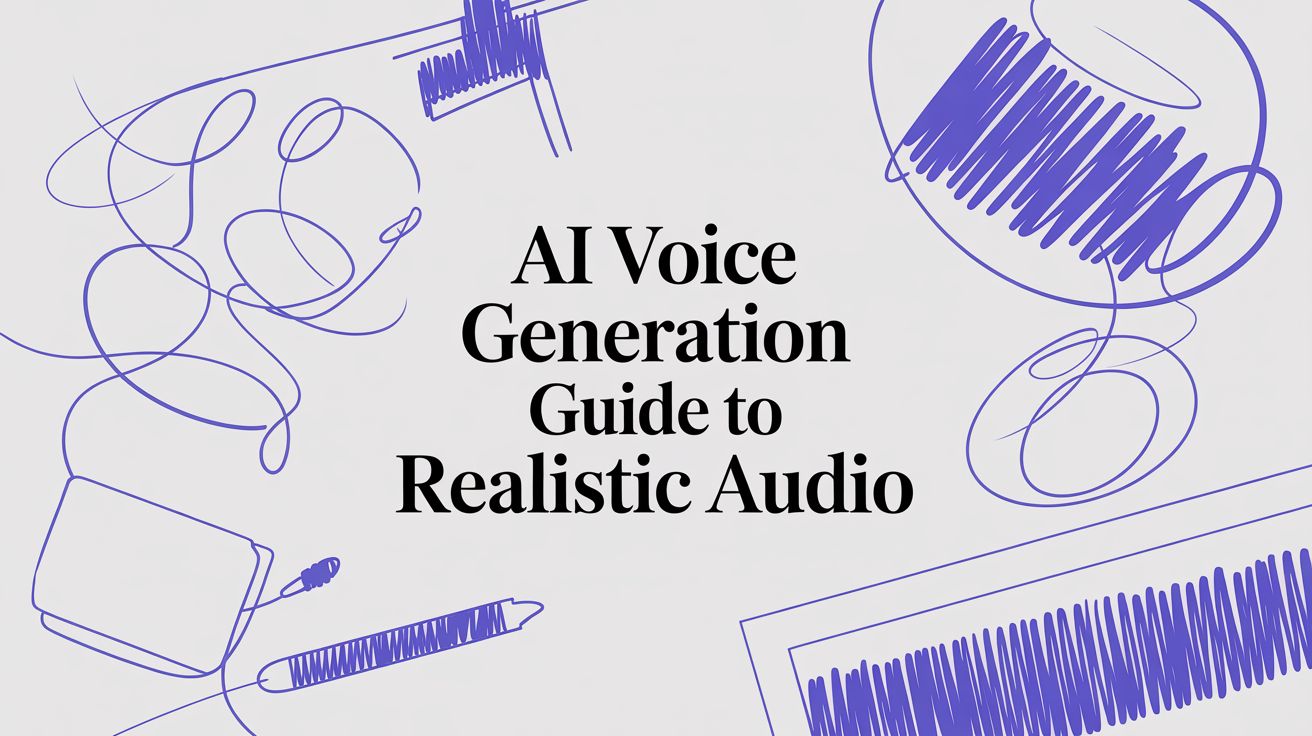
What if you had a professional voice actor on standby, 24/7, ready to bring any script to life? That’s essentially what AI voice generation delivers. This technology uses artificial intelligence to turn written words into incredibly natural-sounding speech, packed with the right tone, inflection, and emotion for your content.
What Is AI Voice Generation and Why It Matters
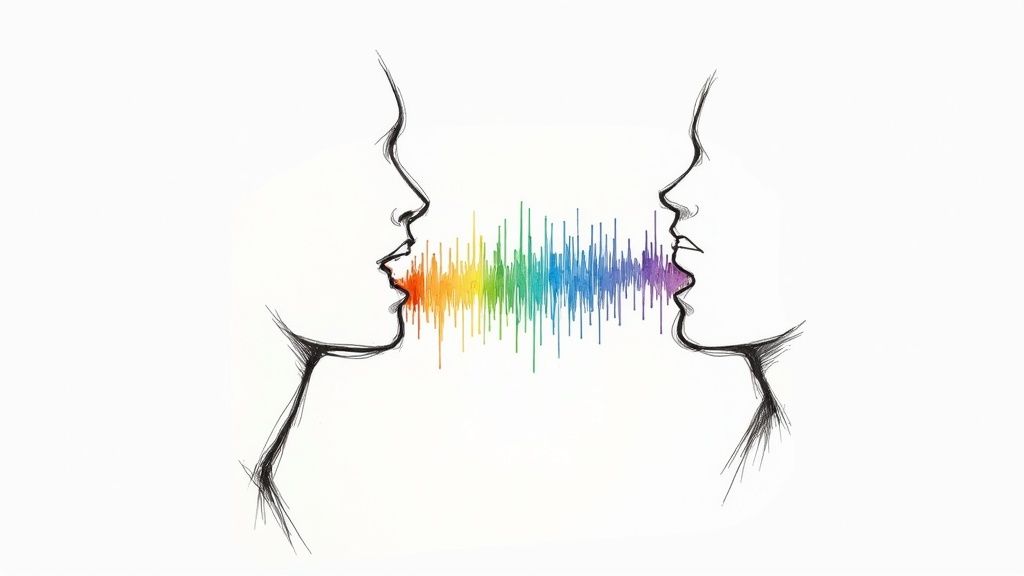
Simply put, AI voice generation is the process of creating synthetic human speech from text. Forget the choppy, robotic narration you might remember from years ago. Today’s systems are so advanced they can analyze the context of a script and produce audio that's often indistinguishable from a real person. This magic is powered by sophisticated AI models trained on immense libraries of human speech.
The technology at the heart of this is called Text-to-Speech, or TTS. Modern TTS has come a long way, evolving from basic word-stitching to generating nuanced performances that can convey happiness, seriousness, or excitement. If you want to dive deeper, you can explore what text-to-speech technology is and how it works in our detailed guide.
The Shift From Robotic to Realistic
So, what changed? The big leap forward came from deep learning. Early TTS systems sounded mechanical because they were just piecing together pre-recorded sounds like a verbal collage. Today’s AI models, however, actually understand sentence structure, punctuation, and context, allowing them to deliver a genuinely natural performance.
This jump in quality has opened up a whole new world of possibilities for creators, marketers, and businesses. The demand isn't just growing—it's exploding. The global market for AI voice generators was valued at around USD 3.5 billion in 2023 and is projected to soar to nearly USD 21.75 billion by 2030. That’s not just a trend; it's a fundamental shift in how we create audio.
Key Benefits of AI Voice Generation at a Glance
The advantages of high-quality AI voices are reshaping industries, offering a powerful mix of efficiency, consistency, and scale that was once only possible with a big budget and a professional recording studio. Here’s a quick summary of what this technology brings to the table.
| Benefit | Impact for Creators and Businesses |
|---|---|
| Cost Efficiency | Slashes the high costs of hiring voice talent, booking studios, and post-production. |
| Speed and Scalability | Lets you generate hours of audio in minutes, perfect for rapid content creation and localization. |
| Brand Consistency | Ensures your brand has a uniform, recognizable voice across all marketing and training materials. |
| Greater Accessibility | Makes written content accessible to people with visual impairments or learning disabilities. |
| Creative Freedom | Unlocks the ability to experiment and produce audio at any scale without budget constraints. |
Ultimately, AI voice generation empowers creators and businesses to produce professional-grade audio on demand, breaking free from the traditional bottlenecks of time, cost, and talent availability.
Actionable Insight: When platforms remove creative barriers—like Verbatik does by offering unlimited text to speech and voice cloning—you’re free to experiment and produce at a massive scale without worrying about surprise fees or usage limits. This is a key advantage for content creators who need to produce in bulk.
This accessibility is why the technology is such a game-changer. Anyone, from a solo podcaster to a global enterprise, can now create pristine audio content quickly and affordably.
How AI Voice Generation Technology Works
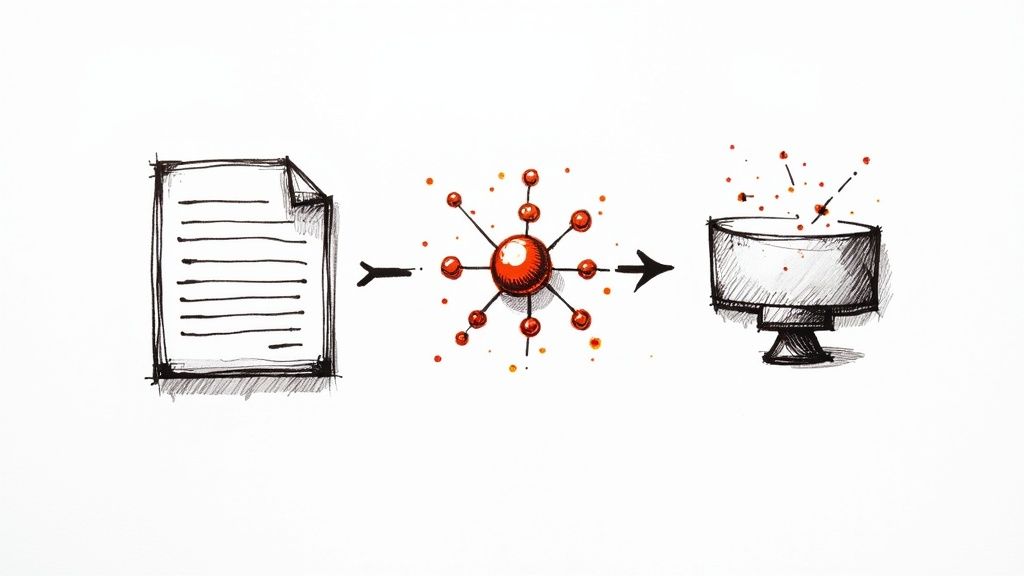
To really get how AI voice generation works, don't think of it like teaching a computer a dictionary. Instead, picture it listening to thousands of hours of real human conversations, audiobooks, and podcasts. That's the heart of it. We've moved from clunky text-to-speech to incredibly sophisticated deep learning models that capture the rhythm and feel of a real person speaking.
The journey started with basic Text-to-Speech (TTS). Early TTS was pretty simple: it would just glue together pre-recorded phonetic sounds to build words. It worked, but you could always tell it was a machine. The result was robotic, choppy, and missed the natural flow we expect from speech.
Today's AI voices are playing a whole different ballgame. They run on advanced neural networks—a type of AI modeled after the human brain—to analyze text and actually predict what it should sound like. This is where things get interesting.
The Power of Neural Networks
Neural networks do more than just read words off a page; they understand context. They analyze punctuation, sentence structure, and the words around a phrase to figure out the right tone, pitch, and speed. Because of this, the AI can generate a smooth, continuous audio waveform from scratch, not just stitch sounds together.
This ability to understand context comes from something called Natural Language Processing (NLP), which is the engine that helps the AI grasp the meaning behind the text. If you want to dive deeper into the nuts and bolts, our guide on demystifying natural language processing breaks it all down.
This deep analysis is what allows the AI to sound so human. It instinctively knows to take a small breath after a comma, raise its pitch when asking a question, or put a little extra punch on an important word—all on its own.
The goal of modern AI voice generation is not just to say the words, but to deliver them with the right intention and emotion. It's the difference between a robot reading a script and a skilled narrator telling a story.
From Generation to Replication: Voice Cloning
The next giant leap forward is voice cloning. This tech goes beyond creating a generic, human-like voice and instead focuses on perfectly replicating a specific person's vocal identity. For anyone looking to build a consistent brand sound, this is the ultimate tool.
The whole process starts by training an AI model on just a small sample of someone's speech. The model listens intently, analyzing the key traits that make a voice unique.
- Timbre: The unique quality and texture of the voice.
- Pitch: The highs and lows that define a person's vocal range.
- Cadence: The natural rhythm and pacing of their speech.
- Inflection: The subtle shifts in tone used to show emotion or emphasis.
Once the AI has this vocal blueprint, it can generate entirely new speech in that exact voice, reading any text you give it. This is what makes tools like Verbatik so powerful. With its offering of unlimited text to speech and voice cloning, you can create a signature voice for your brand and use it everywhere without limits.
Think about it: every piece of audio, from a quick social media ad to a full-blown e-learning course, can feature the same familiar, trustworthy voice. That kind of consistency is huge for building brand recognition and connecting with your audience. As this technology keeps improving, the line between human and AI voices gets blurrier by the day, giving incredible creative power to anyone with a message to share.
Real-World Applications of AI Voice Generation
The true potential of AI voice generation isn't some far-off concept; it's already here, making a real difference in how businesses and creators operate. People are using this tech every day to create professional-grade audio content way faster and cheaper than they could before. From entertainment to corporate training, the applications are as practical as they are powerful.
This isn't just a niche trend. The widespread use of these tools is fueling massive market growth. Projections show the AI voice generator market is expected to jump from about USD 6.4 billion in 2025 to a staggering USD 54.54 billion by 2033. This explosion tells us one thing: this technology is quickly becoming essential. You can dig into the numbers yourself by checking out the full analysis of the AI voice generators market on Straits Research.
Powering the Podcasting and Audiobook Boom
For podcasters, AI voices are a total game-changer. Think about creating polished intros, outros, and ad reads without booking a voice actor. A creator can now generate consistent, professional-sounding clips in seconds, saving a ton of time and money so they can focus on what they do best—creating great content.
It’s a similar story for authors. They're now turning their books into audiobooks at a speed that was once unimaginable. What used to be a long, expensive production process can be knocked out in a fraction of the time, opening the doors to the huge audiobook market for indie authors who couldn't previously afford the steep entry cost.
Actionable Insight: To make long-form content like audiobooks or podcast series affordable, use a platform that offers unlimited text to speech. With a tool like Verbatik, you can produce hours of audio without worrying about word counts or per-character charges, making large-scale projects financially viable.
Enhancing Video Marketing and E-Learning
A crisp, clear voiceover can make or break a video, whether it's for YouTube, a social media ad, or a product demo. AI voice generation gives marketers a virtually endless supply of voice styles, languages, and accents to perfectly match their brand and target audience. This flexibility is huge for A/B testing different voiceovers to see which one gets the best results.
In the corporate world, AI voices are completely overhauling e-learning and training modules. Companies can now create scalable training materials in multiple languages, all narrated by the same professional voice. And if a course needs an update? Just edit the script and re-generate the audio. No need to schedule another recording session with a human actor. You can see a bunch of these applications in action by exploring some of the top AI voice generation use cases.
Creating a Unified Brand Voice
One of the most powerful things you can do with AI voice generation is establish a consistent sonic identity for your brand. We all know how logos and color schemes create visual recognition; a unique brand voice does the same thing for the ears, building familiarity and trust with customers.
- Marketing Campaigns: Imagine every ad, from a radio spot to a digital clip, featuring the same recognizable voice.
- Customer Support: Use a consistent AI voice for your IVR systems and automated support to create a seamless, professional customer experience.
- Product Tutorials: Guide users through your product with a familiar voice they immediately associate with your brand.
This is exactly where voice cloning comes in. By creating a perfect digital replica of a specific voice, a brand can ensure every single piece of audio it puts out is perfectly on-brand, every single time.
Actionable Insight: To achieve true brand consistency, leverage a service with unlimited voice cloning. A platform like Verbatik allows you to create and use a custom brand voice across all your projects without restrictions, ensuring every touchpoint sounds exactly like you.
Your Step-by-Step Guide to Creating AI Voiceovers
Jumping into AI voice generation is way easier than you might think. Forget needing a fancy recording studio or wrestling with complicated software. We'll walk through the whole thing in five simple, clear steps. In just a few minutes, you'll go from curious to capable.
The basic idea is simple: you pick a tool, give it a script, and get back audio. It’s a smooth process from start to finish.
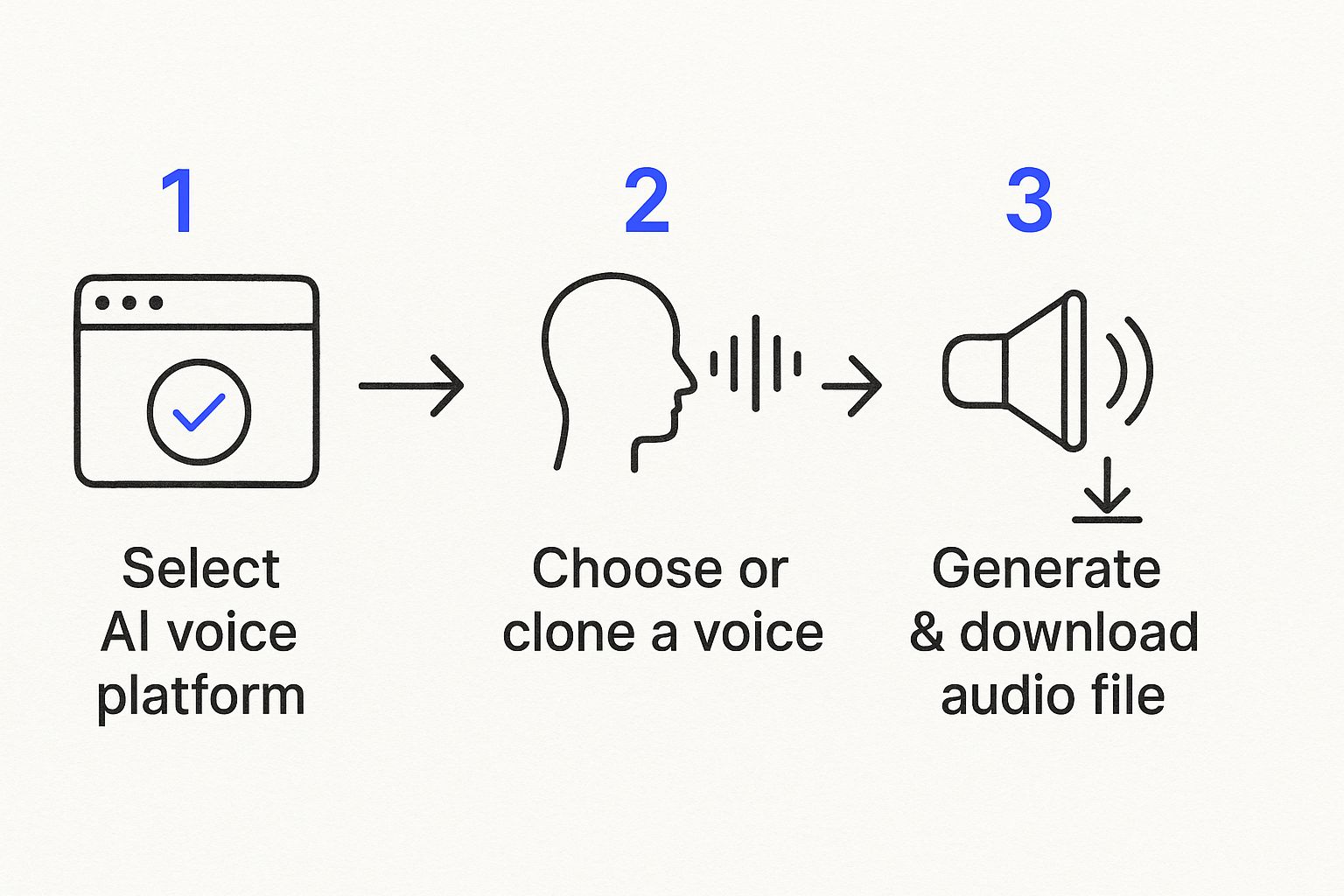
This graphic gives you a bird's-eye view of the workflow. Let's break down each part.
Step 1: Select the Right Platform
First things first, you need to pick an AI voice generator that fits what you’re trying to do. Think about your project. Is this a one-time voiceover, or are you planning to churn out a steady stream of content for YouTube or company training?
Look for a platform that feels easy to use, has plenty of voices, and offers a pricing plan that actually works for you. For serious creators, this is where a service like Verbatik really shines. It provides a powerful solution with its promise of unlimited text to speech and voice cloning, so you can create as much audio as you want without constantly watching your credit balance.
Actionable Insight: Don't just sign up for the first tool you find. Test a few out. Really listen to how natural the voices sound and see how intuitive the interface is. The right tool should feel like it's helping you, not getting in your way.
Step 2: Choose Your Voice
With a platform selected, it’s time for the fun part—picking the voice. Most tools have a huge library of pre-made voices covering different genders, ages, and accents. You can usually filter them by categories like "narrator" or "character" to zero in on the perfect fit.
Want something truly your own? That's where voice cloning comes in. You upload a short recording of your voice (or a voice actor's), and the AI creates a perfect digital copy. It's a fantastic way to build a consistent, recognizable audio brand. For creators juggling multiple projects, platforms that offer unlimited voice cloning like Verbatik are a huge plus.
Step 3: Write and Format Your Script
Now, let's talk about the script. The AI is only as good as the text you give it, so clear and concise writing is key. Remember, the AI will read exactly what you type.
This means punctuation is your best friend. It’s how you direct the AI’s performance.
- A comma (,) tells the AI to take a short, natural breath.
- A period (.) signals a complete stop, with the tone dropping slightly.
- A question mark (?) makes the AI raise its pitch at the end, just like a real question.
- An exclamation point (!) injects a bit of excitement or emphasis.
Actionable Insight: Before you hit "generate," read your script out loud to yourself. It's the quickest way to spot clunky sentences and figure out where you need to add a comma or a period to make the rhythm sound more human.
Step 4: Fine-Tune the Output
Once your script is in and your voice is chosen, you get to play director. This is where you polish the performance. The best platforms give you a set of controls to tweak the vocal delivery.
You can adjust the rate (how fast the AI talks), the pitch (how high or low the voice is), and add custom pauses between words. Small changes here make a massive difference, turning a decent voiceover into a professional-sounding one. This control is especially handy when you're trying to match audio to a video, a topic we cover in our step-by-step guide on making videos with AI text-to-speech.
Step 5: Generate and Download
With everything dialed in, the last step couldn't be simpler: click the "generate" button. The AI will work its magic, and in just a few seconds, your audio file will be ready.
Give it one final listen to make sure everything sounds right. If a word sounds off or a pause is too long, just jump back, tweak your script or settings, and generate it again. Once you’re happy, download the file—usually as an MP3 or WAV—and you're ready to go.
Mastering Advanced Features Like Voice Cloning
Once you get comfortable with the basics of AI voice generation, a whole new world of creative tools opens up. The real game-changer here is voice cloning. This isn't about using generic, off-the-shelf voices anymore; it's about replicating a specific human voice with incredible accuracy.
This is the key to building a sonic brand that people actually remember.
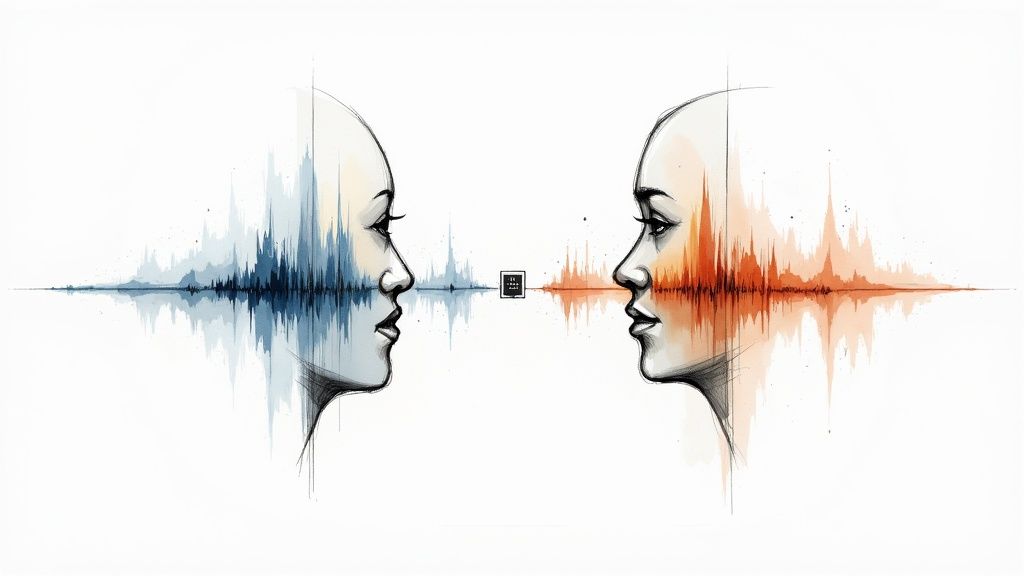
So, how does it work? You feed the AI a short audio sample of someone speaking. The model then gets to work, breaking down all the unique vocal qualities—the specific pitch, tone, and rhythm—to create a digital fingerprint of that voice. From that point on, it can generate brand new speech from any script you give it, all in that same, unique voice.
For any brand trying to maintain a consistent feel across social media ads, e-learning modules, and internal videos, this kind of technology is a massive advantage.
Standard AI Voice vs. Cloned AI Voice
Deciding between a standard AI voice and a custom cloned voice can be tricky. Standard voices are great for quick, general-purpose tasks, but a cloned voice is an investment in your brand's unique identity. Here's a quick breakdown to help you choose the right tool for the job.
| Feature | Standard AI Voice | Cloned AI Voice (e.g., Verbatik) |
|---|---|---|
| Uniqueness | Generic, available to all users | Exclusive to you; a unique sonic identity |
| Brand Identity | Low brand recognition | High brand recognition and consistency |
| Emotional Connection | Can feel impersonal | Builds familiarity and trust with audiences |
| Setup Time | Instant access | Requires a short audio sample for cloning |
| Best For | General voiceovers, internal drafts | Branded content, marketing, e-learning |
Ultimately, a standard voice gets the job done, but a cloned voice gives your brand a soul. It makes your content instantly recognizable in a sea of noise.
The Power of a Unique Sonic Identity
A cloned voice makes your brand instantly recognizable. Think about it: just like a logo creates a visual shortcut for your brand, a unique voice creates an auditory one. It builds trust and forges a much deeper connection with your listeners.
Historically, though, voice cloning was expensive and technically complicated, putting it out of reach for most creators. That’s why a platform that offers unlimited text to speech and voice cloning, like Verbatik, is such a big deal. It completely removes those old barriers, letting you create distinct voices for different clients, projects, or brand personas without ever hitting a paywall.
Actionable Insight: By creating a custom cloned voice, you're not just producing audio; you're building a sonic brand asset. This voice becomes synonymous with your identity, making every piece of content instantly and unmistakably yours.
Producer-Level Control Beyond Cloning
But truly advanced AI voice generation is about more than just the voice itself—it’s about directing the performance. The best platforms give you the kind of granular control that used to be reserved for audio producers in a studio.
Two features are absolutely essential for this:
- Emotional Tone Control: This lets you inject real feeling into the speech. You can select tones like "excited," "somber," "professional," or "friendly" to make sure the delivery perfectly matches the message.
- SSML Tags: For pinpoint accuracy, you can use Speech Synthesis Markup Language (SSML) tags right in your script. These are simple bits of code that tell the AI exactly how to pronounce words, where to pause, and how to adjust the volume or speed for specific phrases.
If you want to get into the nuts and bolts of how this all works, check out our deep dive on the fundamentals of voice cloning technology. Getting a handle on these tools gives you an incredible amount of creative freedom.
The demand for these advanced, personalized audio solutions is fueling some serious growth. Market analyses from 2025 project the AI voice generator industry will skyrocket from around USD 3.0 billion in 2024 to USD 20.4 billion by 2030. This boom is a clear signal that high-quality, custom audio is becoming essential for everything from virtual assistants to digital marketing. You can discover more insights about AI voice generator market growth on GlobeNewswire.
When you combine voice cloning with fine-tuned emotional and phonetic controls, you can create audio that isn't just realistic—it's perfectly aligned with your vision. And with platforms offering unlimited text to speech and voice cloning, professional-grade custom audio is no longer a luxury. It's a practical, powerful tool for any creator.
How to Choose the Right AI Voice Tool
Picking the right tool for AI voice generation can feel like a chore, but it doesn't have to be. The best choice isn't about flashy features; it’s about finding the platform that genuinely fits what you're trying to accomplish. You've got to look past the marketing noise and zero in on what actually matters for your project.
The absolute first thing to check is the quality and naturalness of the voices. Take a minute to actually listen to the audio samples. Do they sound like a real person, with normal rhythms and pauses, or can you still hear that subtle robotic flatness? That small difference is what separates content that sounds professional from stuff that just feels… cheap.
Core Criteria for Evaluation
Beyond just the voice quality, you need to dig a bit deeper. A solid platform gives you more than one good voice; it provides a whole toolkit to get you from a script to a finished audio file without pulling your hair out.
Before you even think about signing up, make sure you're clear on these points:
- Voice Variety: How big is the library? You need a good range of voices, accents, and languages if you want to connect with different audiences or create unique characters for your content.
- Ease of Use: Is the interface actually intuitive? You shouldn't need a degree in audio engineering to generate and tweak a voiceover. It should be fast and simple.
- Customization Options: Can you control the little things? Being able to adjust the speed, pitch, and emotional tone is what lets you fine-tune the delivery to perfectly match your script.
To get a feel for what's out there, it's a good idea to explore the various AI voice tools available and see how different platforms handle these basics.
The Decisive Factor: Pricing Models
Finally, let's talk about the deal-breaker for most people: the price. A lot of tools run on a credit-based system where you pay for every character or word. This might seem fine for short clips, but it can get brutally expensive if you’re creating podcasts, audiobooks, or entire e-learning courses.
This is where a different approach can completely change the game.
Actionable Insight: For creators who produce a ton of content—think agencies, YouTubers, and course developers—a platform like Verbatik offering unlimited text to speech and voice cloning is a lifesaver. It gets rid of that constant anxiety of watching your usage meter. You can experiment, re-record, and produce as much as you need, knowing your budget is helping your creativity, not holding it back.
When you match a tool's features and its pricing model to your actual needs, you find a partner that not only gives you great audio but also supports your growth without any nasty surprises on your monthly bill.
Your Questions About AI Voice Generation, Answered
As AI voice generation tools become a staple for creators, it's natural to have questions. You're probably wondering about how it all works, what the rules are, and how to get the most out of it. We've gathered the most common questions we hear to give you the clear, straightforward answers you need to start creating with confidence.
Can I Use AI-Generated Voices for Commercial Projects?
Absolutely, as long as you stick with a reputable platform. When you generate audio using a service like Verbatik, you're granted the commercial and broadcast rights for any voice in their library. This means you can use the audio for your marketing campaigns, YouTube channel, online courses, or any other business project, completely worry-free.
Voice cloning, however, is a different story. The legal and ethical lines are much clearer here: you absolutely must have explicit, written consent from the person whose voice you're cloning. Trying to use someone's voice without their permission is a serious breach of trust and can land you in legal hot water.
Can AI Voices Actually Sound Emotional?
We’ve come a long, long way from the monotone, robotic voices of the past. Today’s top platforms give you control over the emotional delivery, letting you choose styles like happy, sad, or professional to fit the vibe of your script. While an AI can't truly feel emotion, it can convincingly replicate the tones and inflections that make a voice sound engaging and human.
Actionable Insight: The real magic is in the direction you provide. Think of yourself as a director guiding an actor. By using punctuation thoughtfully and selecting the right emotional presets, you can shape the AI's delivery to match your vision, creating a performance that genuinely connects with your audience.
How Much Does This All Cost?
Pricing models for AI voice generation are all over the map. Some tools will charge you by the character or by the minute. This can work for short projects, but for longer content like audiobooks or podcasts, the costs can spiral quickly, and it often discourages you from experimenting to get the perfect take.
A much more creator-friendly approach is a subscription that offers unlimited use. Platforms like Verbatik, for example, provide unlimited text to speech and voice cloning. This is a huge advantage for anyone producing content regularly, letting you create and tweak as much as you need without watching the meter run. It makes professional-grade audio accessible no matter your budget.
For more deep dives into this topic, the Paraspeech Blog for In-depth Articles is a fantastic resource.
Ready to hear the difference for yourself? Verbatik gives you a full creative suite, including unlimited text to speech and voice cloning, and even AI tools for music and video. Start producing studio-quality audio in minutes by exploring all the features at https://verbatik.com.
